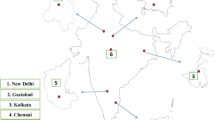Abstract
Most waste sites in Zimbabwe are not sanitary landfills but open dumps that indiscriminately receive waste from municipalities, industries, commercial establishments, and social services establishments. People, including children, who eke out a living through scavenging the dumps expose themselves to environmental pollutants at the dumps via inadvertent ingestion and inhalation of contaminated dust, and dermal absorption. The public is potentially being exposed to a slew of the pollutants via air, water, and food, all contaminated by uncontrolled leachates and aerially deposited dust and particulates from the sites. One of the unfortunate consequences of globalization is the sharing of contaminated food and the associated disease burdens; hence, regional contamination can have global impacts. We analyzed the levels of lead at two waste sites in Zimbabwe to assess the daily exposure levels of Pb to children and adults who scavenge the sites as well as determine levels of the heavy metal that are potentially contaminating air, water, soils, and food in the country. Levels of Pb ranged from 23,000 to 14,600,000 µg/kg at one of the sites and from 30,000 to 1,800,000 µg/kg at the other. Inadvertent daily exposure amounts that were calculated by assuming an inadvertent daily ingestion of 20–500 mg of soil/dust were mostly higher than the provisional tolerable daily intake established by the World Health Organization for infants, children, and adults. The XRF measurements were validated using certified reference samples, 2710a (Montana soil) and 2781 (domestic sludge), from the National Institute of Standards and Technology.
Similar content being viewed by others
References
Aminul, H. M. (2016). Assessment of nickel leaching phenomena from landfill waste mixed paving block for eco-friendly field application. Journal of Cleaner Production, 139, 99–112.
Beyene, H., & Banerjee, S. (2011). Assessment of the pollution status of the solid waste disposal site of Addis Ababa City with some selected trace elements. Ethiopia. World Applied Sciences Journal, 14(7), 1048–1057.
Chuangcham, U., Wirojanagud, W., Charusiri, P., Milne-Home, W., & Lertsirivorakul, R. (2008). Assessment of heavy metals from landfill leachate contaminated to soil: A case study of Kham Bon landfill, Khon Kaen Province, NE Thailand. Journal of Applied Sciences, 8(8), 1383–1394.
Go Bassing in Africa, Darwendale Dam, Zimbabwe. (2016). http://www.gobassing.com/display.php?Countries+Zimbabwe+Darwendale. Accessed October 2016.
Guerrero, L. A., Maas, G., & Hogland, W. (2013). Solid waste management challenges for cities in developing countries. Waste Management, 33, 220–232.
Huang, Z.-Y., Chen, T., Yu, J., Qin, D.-P., & Chen, L. (2012). Lead contamination and its potential sources in vegetables and soils of Fujian, China. Environmental Geochemistry and Health, 34(1), 55–65.
Li, J. X., Yang, X. E., He, Z. L., Jilani, G., Sun, C. Y., & Chen, S. M. (2007). Fractionation of lead in paddy soils and its bioavailability to rice plants. Geoderma, 141(3–4), 174–180.
Marunya, K. (2013). New landfill to replace Pomona dump. http://www.hararenews.co.zw/2013/12/new-landfill-to-replace-pomona-dump/. Accessed October 2016.
National Institute of Environmental Sciences (2011). Kids environment kids health: Lead poisoning. http://kids.niehs.nih.gov/topics/pollution/lead/index.htm. Accessed October, 2016.
Olafisoye, O. B., Adefioye, T., & Osibote, O. A. (2013). Heavy Metals Contamination of Water, Soil, and Plants around an Electronic Waste Dumpsite. Pol. J. Environ. Stud., 22(5), 1431–1439.
Olorode, D. O., & Alao, A. O. (2013). Geo-electrical investigation of underground water contamination by solid waste: Case study of Solous III dumpsite, Igando, Lagos, Nigeria. Advances in Applied Science Research, 4(4), 420–431.
Pedersen, T.L.(1997). Drinking water contamination by dumps and landfills. http://extoxnet.orst.edu/faqs/safedrink/dumps.htm. Accessed October 18, 2016.
Prabhavathi, M., Sreenivasulu, R. K., & Indirani, R. (2010). Effect of municipal waste on quality of irrigation water in Tirupati, Andhra Pradesh, India. Indian Journal of Environment and Ecoplanning, 17(1–2), 343–350.
Prechthai, T., Parkpian, P., & Visvanathan, C. (2008). Assessment of heavy metal contamination and its mobilization from municipal solid waste open dumping site. Journal of Hazardous Materials, 156(1–3), 86–94.
Robinson, B. H. (2009). E-waste: An assessment of global production and environmental impacts. Science of The Total Environment, 408(2), 183–191.
U.S. Department of Health and Human Services (2003). Technology planning and management corporation. In Report on carcinogens background document for lead and lead compounds; contract number N01-ES-85421. http://ntp.niehs.nih.gov/ntp/newhomeroc/roc11/lead-public_508.pdf Accessed October, 2016.
U.S. Environmental Protection Agency (2016). Learn about lead. https://www.epa.gov/lead/learn-about-lead#effects. Accessed October 18, 2016.
Whitehead, N. S., Leiker, R. (2007). Case management protocol and declining blood lead concentrations among children. Prev Chronic Dis [serial online] 2007 Jan [date cited]. http://www.cdc.gov/pcd/issues/2007/jan/06_0023.htm Accessed October 18, 2016.
World Health Organization (2010). Preventing disease through healthy environments, exposure to lead: A major public health concern. http://www.who.int/ipcs/features/lead..pdf Accessed October 18, 2016.
Wua, Q., Leungc, J. Y. S., Gengd, X., Chene, S., Huanga, X., Lif, H., et al. (2015). Heavy metal contamination of soil and water in the vicinity of an abandoned e-waste recycling site: Implications for dissemination of heavy metals. Science of the Total Environment, 506–507, 217–225.
Zhang, W.-H., Wu, Y.-X., & Simonnot, M. O. (2012). Soil contamination due to e-waste disposal and recycling activities: A review with special focus on China. Pedosphere, 22(4), 434–455.
Zimbabwe National Statistics Agency (2012). Population Census 2012 Provinces Reports. http://196.43.99.13/population-census-vital. Accessed October 2016.
Acknowledgements
The authors wish to thank the School of Science and the Department of Chemistry, Medical and Physics at Monmouth University for financial support.
Author information
Authors and Affiliations
Corresponding author
Rights and permissions
About this article
Cite this article
Tongesayi, T., Kugara, J. & Tongesayi, S. Waste dumpsites and public health: a case for lead exposure in Zimbabwe and potential global implications. Environ Geochem Health 40, 375–381 (2018). https://doi.org/10.1007/s10653-017-9917-6
Received:
Accepted:
Published:
Issue Date:
DOI: https://doi.org/10.1007/s10653-017-9917-6




